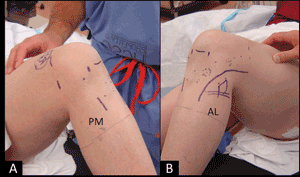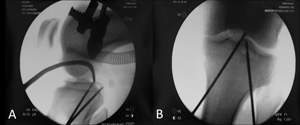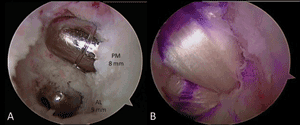Optimal PCL reconstruction depends on understanding the anatomy and biomechanics
SAN DIEGO — Ongoing research into the science of the PCL coupled with his more than 20 years experience studying and treating injuries to this ligament, both operatively and nonoperatively, have guided Christopher D. Harner, MD, in his current approach to patients with PCL injuries including decisions about tunnel placement, single- vs, double-bundle, and graft selection.
Harner presented his surgical decision-making experience at the Arthroscopy Association of North America 2011 Specialty Day Meeting here, noting that he treats most isolated PCL injuries nonoperatively.
“Decisions regarding single-bundle and double-bundle and augmentation techniques are based on injury patterns and insertion-site anatomy,” he said.
Furthermore, all secondary restraints must be addressed in these patients, he added.
Harner, a professor at the University of Pittsburgh Medical Center and the Blue Cross of Western Pennsylvania Endowed Chair in Orthopaedic Surgery, reviewed his step-by-step decision-making process for managing PCL injuries and discussed the rationale for each step at the meeting, mostly focusing on the nuances of the tunnel placement on the femur and tibia.
Base decisions on anatomy
|
Images: Harner CD |
Harner urged his colleagues to familiarize themselves with the three components of the PCL, noting the anterolateral (AL) component is largest and strongest. “It should be the focus of your reconstruction,” he said. According to Harner, decisions regarding tunnel placement and graft type should all be made with replicating the strength and position of the specific PCL component.
“My approach will be highly influenced by my findings from the exam under anesthesia. This is the most important information I use to decide what surgical approaches I will take,” Harner said.
However, MRI findings can affect his decision-making by providing additional important information to what he discovers during the exam under anesthesia. Often he will also use intraoperative fluoroscopy to further define the damaged ligaments.
Harner’s experience has been that approximately one-half of the PCL injuries he manages are isolated grade 1 or 2 tears that are treated nonoperatively. He reported that between 2001 and 2004 he treated 165 combined ligament injuries that involved the PCL
|
|
Treatment of isolated PCL-injured knees involves bracing for 4 weeks to protect the partially injured PCL and often also the partially injured posterolateral PCL corner. “The PCL unlike the ACL has the potential to heal with nonoperative treatment,” Harner told Orthopedics Today. “But you must protect the injured PCL from having the tibia sublux posteriorly for 4 to 6 weeks after the injury. For an athlete with a grade 1 or 2 PCL injury it usually takes 4 to 8 weeks before they are ready to return to their sport.”
Three operative approaches
For the majority of cases involving the PCL, Harner is doing both the PCL and posterolateral corner but not the lateral collateral ligaments (LCLs). “These are posterior and posterolateral rotational laxity injuries and not the varus injuries involving the LCL. This is important because if the surgeon misses a posterolateral laxity and only does the PCL reconstruction, the PCL graft will be doomed to failure.”
Injury pattern a factor
|
|
Harner used videos to review how he selects arthroscopic portals for anatomical tunnel locations, drilling for the tunnels and passing the grafts.
Currently he uses allograft approximately 70% of the time and quadricepts tendon autograft in 30% of his PCL reconstruction. He uses an AO screw and washer rather than interference screws to fix all the grafts.
Postoperatively, patients are protected with a brace in fill extension for 4 weeks. At 4 weeks, rehabilitation involves the brace is unlocked for mini-squats and walking with crutches. Crutches are discontinued after 4 weeks and a quadriceps rehabilitation program is started. He strongly recommended not using a CPM for early postoperative rehabilitation. Return to sports usually occurs between 9 and 12 months, Harner said. – by Susan M. Rapp
Reference:
- Harner CH, Miller TL. Posterior cruciate ligament surgery: Decision making. Presented at the Arthroscopy Association of North America 2011 Specialty Day Meeting. Feb. 19. San Diego.
- Christopher D. Harner, MD, is the Medical Director of the University of Pittsburgh Medical Center (UPMC) Center for Sports Medicine. He can be reached at 3471 Fifth Ave., Pittsburgh, PA 15213; 412-432-3661; e-mail: harnercd@upmc.edu.
- Disclosure: His institution receives research and educational support from Smith & Nephew and DePuy Mitek.
Dr. Harner’s approach to PCL injuries reminds us that all PCL injuries are not alike and should not be treated in a “cookie-cutter” type manner. Besides the various grades of PCL injury, there are various associated secondary injuries which may influence the type of PCL reconstruction (double- vs. single-bundle) and type of graft material utilized. Dr. Harner stresses the importance of the pre-operative planning; including a detailed examination under anesthesia, which I feel is a lost art in this day of high-resolution MRI scanning. Fluoroscopy use during exam under anesthesia can greatly assist in determining associated pathology. The use of Dr. Harner’s systematic approach should only help to improve clinical outcomes in the treatment of PCL injuries in my practice.
— Julie A. Dodds, MD
Associate Clinical
Professor
Division of Sports Medicine
Michigan State University, East
Lansing, Mich.
Session moderator
Disclosure: She has no relevant
financial disclosures.



